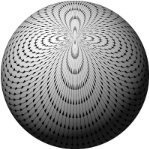-
Posts
4360 -
Joined
-
Last visited
About tar
- Birthday 12/11/1953
Profile Information
-
Location
VA
-
Interests
The computer game "Civilization", trying to figure out the stock market, philosophy of life, and scientific unanswered questions.
-
College Major/Degree
BS in Business
-
Favorite Area of Science
Physics
-
Biography
Married, 2x grandfather.
-
Occupation
Retired
Retained
- Baryon
Recent Profile Visitors
The recent visitors block is disabled and is not being shown to other users.
tar's Achievements

Scientist (10/13)
152
Reputation
-
If the spiral arm of a galaxy contains a lot of stars and mass and you pick a point on the fringes of the galaxy the gravitational pull of the arm will speed up a mass that is "behind" it, rotationally and retard the rotational movement if it is"ahead" of the arm and the arm would add to the gravitation mass of the center of the galaxy if center of mass of the arm was between the fringe point and the center of mass of the galaxy. Thus "when" the arm is in the various positions relative to the fringe point matters in terms of the acceleration the arm's mass will impart on the fringe point. swansont, the galaxy pictured was seen from its axis of rotation. All the fringe was equal distant more or less. An edge on galaxy the far side would be further away and hence what you saw of it was its position a long time before what you see on the closer edge. Regards, TAR edge on the close edge is more recent than the far edge. Looking from the axis of rotation the edges are all approximately equal in age. If my theory is correct the rotational speeds of galaxies viewed from the axis of rotation would be more consistent with Kepler's law than galaxies viewed edge on. I do not know if there are observations categorized in this manner. Edge on or from the axis of rotation. not theory, not even hypothesis. If my speculation is correct the edge on galaxy would be figured to require more dark matter to explain its rotation than the axis viewed galaxy because the time component is not throwing off the observation as much in the axis view
-
I am not sure why you know the center is not rotating. Don't you have to watch a galaxy for a thousand years before you notice a change in position of a unique star? You can only use red shift and blue shift if the galaxy is edge on. Looking at it form the axis you don't know any of it is rotating. SwansonT, long time no argue with. Good to see you. Well Jupiter did not have a strong gravitational pull until it formed out of the accretion disc of the solar system. You cannot measure Jupiter's gravitational effect on Sirius unless there is a Jupiter. '
-
Thread. Lets say mass accretes and tiny pieces of matter gather in one location to make a massive object. This mass does not instantly affect all the rest of the universe, does it? Objects close to it I would imagine are effected first and objects further away later. After a time X after accretion a close object has been subjected to its gravity for nearly all of time X whereas an object far away from the accretion is yet to fell its effects.
-
yes i like the MOND solution. I am maybe turning to looking for an explanation of the difference in gravity effects at large distances that would help base the MOND solutionk that involves the delay in gravity's effect on distant objects based on the "speed" of gravity. Thus timing and the consideration of which parts of the model exist "at the same time" becomes pertinent. Regards, TAR I notice that we are seeing it from its axis of rotation. That is, if we look at a galaxy edge on the closer part of the galaxy is on the edge closest to us but here the fringes of the galaxy are all the same distance, hence happening at the same time as the other portions of the fringe. Although I would still imagine that the center of the pictured galaxy is closer to us then are its fringes. Thus implying that we see the rotation near the center before we see the rotation at the fringes that was occurring simultaneously Regards, TAR
-
I understand I am lacking in the math department exchemist, but I am not there yet with this idea. I am trying to set the assumptions and groundwork for expecting the universe to be connected to itself and be composed of ordinary matter and energy that we have been studying for years and know a lot about. If something only fits the math and has not correlation to reality and ordinary matter and energy, what is the use of it? It is like people finding PI to the quadrillionth digit. Why? You cannot measure or fabricate to that precision so what is it for? I think math is very useful, but it is a symbol system. You have to know what is standing for what. You have to be able to say it words to know what you are setting to what and what relationship you wish to illustrate. You cannot for instance figure that half a cow will give half as much milk. Half a cow would give half as much hamburger.
-
I think I will retire from the discussion for a while. I am trying to offer a required adjustment to our understanding of galactic rotation and you are trying to teach me the standard model, which is find currently in trouble. Dark Matter to me is much like the epicycles of the planets observed. The standard model keeps requiring changes in the cosmological constant and the age of the universe and such and requires the place be made up 95% by dark matter and energy and never observed either one. We infer the presence of such to true the model with observations. Perhaps we can true the observations with our model by adjusting our model, not by proposing imaginary particles and forces.
-
Genady, We cannot know the position and velocity of a particle such as an electron of an atom with certainty. what makes you think we can know the position and velocity of a star with certainty?
- 39 replies
-
-1
-
suppose a star is seen at vector A but is 10 ly away and has traveled in those 10years it took the light to reach us to vector B. Does the Kepler equation used to figure the speed of rotation of the galaxy use vector A as the star's position or vector B? Genady, I have mused on this quite a bit. I have some relativity books downstairs and have discussed this on this forum in the past. My thought is that one CAN assume simultaneity regardless of observer by positing the godlike perspective that puts everything in the universe currently existent at the age of the universe. Of course we cannot see it because it take light time to get here. We NEVER see the universe as it is presently, we always see it as it was when the light that left it, left it. The "same" time is observer dependent and as you say an observer closer to the event sees it before an observer more distant, but the fact remains that the event occured already and other events other places in the universe occurred at that same moment. Regards, TAR
-
Sorry but the article was not comprehensible to me. I talked about motion in the early universe and later and now and miscalculations and previous definitions of dark matter and the expansion rate of the universe and such and I have no idea how they have come up with such things and what they are trying to say. Bottom line, they seem to not have "found" the particle required to account for the dark matter they need in their velocity of rotation calculations. This makes me double down on my speculation. Perhaps they are trying to apply kepler's law concerning the solar system to the Galaxy and perhaps the size of the galaxy affects the gravity between the components in such a way as interactions are not instantaneous and the gravitational effects are delayed and speed of rotation is NOT as if a fixed connected disk is rotating but the gravitational "pulls" are at vectors related to where mass "was" not to where mass currently "is". A consideration of mine that is not mainstream. Relativity assumes there is no special frame of reference. I assume that here and now is our special frame of reference and we can subtract and add back and such to figure what the orientation and arrangement of the universe around us is most likely currently like, as well as what is was like at various times in the past. Nothing we see is current. It is all old news, but we can imagine things progressing without us seeing their progression yet. So if you imagine where a star you see in the night sky actually exists currently you are looking at it from a Godlike perspective.
-
The whole idea of dark matter came about by studying the motion of a supernova in a distant galaxy I use them here to point out that someone measuring the rotation of our galaxy based on a supernova is looking at a supernova that already happened here long ago. We saw it long after it occurred and the other galaxy sees it long after we saw it. Not sure. I base my concerns on stuff I have read in the past. I mentioned some of what I am mentioining not on this forum years ago. I do not know which of what I have said is currently incorporated into the calculations.
-
Let me ask the question this way. How many supernovas are there currently in our galaxy? All depends on what you consider currently. In actually the supernovas currently going on in our galaxy are not know to us. It take their light thousands of years to get to us. Astronomers 2 or 5 or 10k years from know will see them. you are suggesting everyone already takes the time and distance into consideration but I know for a fact that people, scientists in particular use the word now and mean different things without "mentioning" what they are calling now.
-
dark matter is by definition not observed Perhaps we know but perhaps not Genady. For instance it is NOT usually mentioned whether we are considering the position of an observed star as it was when the light left it, as it appears to be now or as it actually is after traveling around the Millky Way center for the time it took the light to reach us. Three different positions. We perhaps know how to calculate the differences but what is the assumption being made by the calculator as to what is being held as the reference and what difference is being caluculated. Like I said, everything in your mind happens at the same time, everything you observe already happened as long ago as the distance



